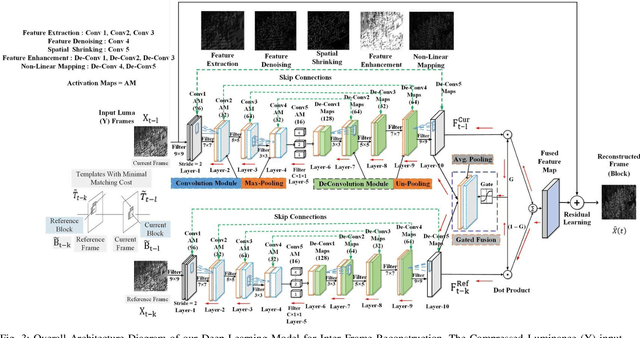Shiba Kuanar
Gated Fusion Network for SAO Filter and Inter Frame Prediction in Versatile Video Coding
May 25, 2021



Abstract:To achieve higher coding efficiency, Versatile Video Coding (VVC) includes several novel components, but at the expense of increasing decoder computational complexity. These technologies at a low bit rate often create contouring and ringing effects on the reconstructed frames and introduce various blocking artifacts at block boundaries. To suppress those visual artifacts, the VVC framework supports four post-processing filter operations. The interoperation of these filters introduces extra signaling bits and eventually becomes overhead at higher resolution video processing. In this paper, a novel deep learning-based model is proposed for sample adaptive offset (SAO) nonlinear filtering operation and substantiated the merits of intra-inter frame quality enhancement. We introduced a variable filter size multi-scale CNN (MSCNN) to improve the denoising operation and incorporated strided deconvolution for further computation improvement. We demonstrated that our deconvolution model can effectively be trained by leveraging the high-frequency edge features learned in a parallel fashion using feature fusion and residual learning. The simulation results demonstrate that the proposed method outperforms the baseline VVC method in BD-BR, BD-PSNR measurements and achieves an average of 3.762 % bit rate saving on the standard video test sequences.
Multi-scale Deep Learning Architecture for Nucleus Detection in Renal Cell Carcinoma Microscopy Image
Apr 28, 2021



Abstract:Clear cell renal cell carcinoma (ccRCC) is one of the most common forms of intratumoral heterogeneity in the study of renal cancer. ccRCC originates from the epithelial lining of proximal convoluted renal tubules. These cells undergo abnormal mutations in the presence of Ki67 protein and create a lump-like structure through cell proliferation. Manual counting of tumor cells in the tissue-affected sections is one of the strongest prognostic markers for renal cancer. However, this procedure is time-consuming and also prone to subjectivity. These assessments are based on the physical cell appearance and suffer wide intra-observer variations. Therefore, better cell nucleus detection and counting techniques can be an important biomarker for the assessment of tumor cell proliferation in routine pathological investigations. In this paper, we introduce a deep learning-based detection model for cell classification on IHC stained histology images. These images are classified into binary classes to find the presence of Ki67 protein in cancer-affected nucleus regions. Our model maps the multi-scale pyramid features and saliency information from local bounded regions and predicts the bounding box coordinates through regression. Our method validates the impact of Ki67 expression across a cohort of four hundred histology images treated with localized ccRCC and compares our results with the existing state-of-the-art nucleus detection methods. The precision and recall scores of the proposed method are computed and compared on the clinical data sets. The experimental results demonstrate that our model improves the F1 score up to 86.3% and an average area under the Precision-Recall curve as 85.73%.
Night Time Haze and Glow Removal using Deep Dilated Convolutional Network
Feb 03, 2019



Abstract:In this paper, we address the single image haze removal problem in a nighttime scene. The night haze removal is a severely ill-posed problem especially due to the presence of various visible light sources with varying colors and non-uniform illumination. These light sources are of different shapes and introduce noticeable glow in night scenes. To address these effects we introduce a deep learning based DeGlow-DeHaze iterative architecture which accounts for varying color illumination and glows. First, our convolution neural network (CNN) based DeGlow model is able to remove the glow effect significantly and on top of it a separate DeHaze network is included to remove the haze effect. For our recurrent network training, the hazy images and the corresponding transmission maps are synthesized from the NYU depth datasets and consequently restored a high-quality haze-free image. The experimental results demonstrate that our hybrid CNN model outperforms other state-of-the-art methods in terms of computation speed and image quality. We also show the effectiveness of our model on a number of real images and compare our results with the existing night haze heuristic models.
 Add to Chrome
Add to Chrome Add to Firefox
Add to Firefox Add to Edge
Add to Edge